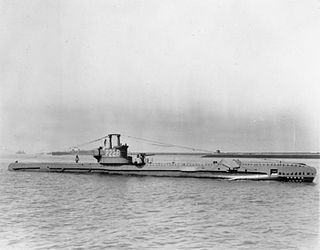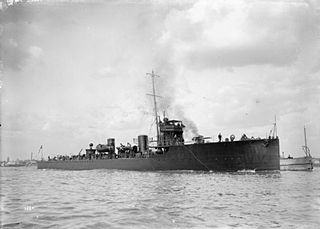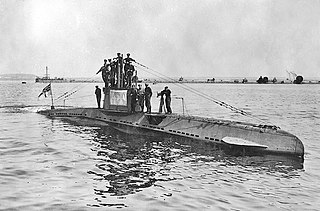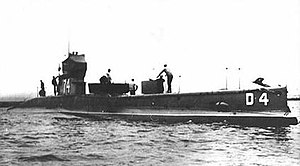
HMS Upholder (P37) was a Royal Navy U-class submarine built by Vickers-Armstrong at Barrow-in-Furness. She was laid down on 30 October 1939, launched on 8 July 1940 by Mrs. Doris Thompson, wife of a director of the builders. The submarine was commissioned on 31 October 1940. She was one of four U-class submarines which had two external torpedo tubes at the bows in addition to the 4 internal ones fitted to all boats. They were excluded from the others because they interfered with depth-keeping at periscope depth.

The British L-class submarine was originally planned under the emergency war programme as an improved version of the British E-class submarine. The scale of change allowed the L class to become a separate class.

HMS Afridi was a Tribal-class destroyer of the Royal Navy launched in 1907 and sold for scrap in 1919. During the First World War she served in the North Sea and the English Channel with the 6th Destroyer Flotilla and as part of the Dover Patrol.

The D-class submarine was the Royal Navy's first class of submarines capable of operating significantly beyond coastal waters. They were also the first boats to be fitted with wireless transmitters. Ten were laid down between 1907 and 1910, though only 8 were completed as D-class boats. The final two hulls were completed as British E-class submarine.

HMS Splendid was a third-batch S-class submarine built for the Royal Navy during World War II. She was laid down on 7 March 1941 and launched on 19 January 1942. After an initial patrol through the Bay of Biscay to Gibraltar, Splendid conducted two patrols in the Mediterranean Sea; one was abandoned after technical problems and on the other she sank two Italian ships. On her next patrol, the submarine attacked two Italian convoys, sinking an Italian destroyer in the second attack. Based in Algiers, the boat operated north of Sicily, sinking six Italian ships, including two tankers and two heavy merchant ships. Splendid was detected by a German destroyer on 21 April 1943 while patrolling off Naples, Italy; the submarine was attacked with depth charges by the destroyer and forced to surface, after which she was scuttled and her surviving crew members taken prisoner. She was the most successful British submarine by tonnage sunk between November 1942 and May 1943.

HMS Sickle was a third-batch S-class submarine built for the Royal Navy during World War II. Completed in 1942, she made her initial war patrol off the Norwegian coast. Sickle then sailed to Gibraltar, from where she conducted one patrol, then to Algiers, French North Africa. From 10 May to 10 October, the boat patrolled the Gulf of Genoa five times and sank a German submarine as well as three minesweepers and an escort ship. She then moved to Beirut, French Lebanon, and conducted two patrols in the Aegean Sea, sinking three caïques and a merchant ship, in addition to landing resistance operatives in Greece.

HMS Stratagem was a third-batch S-class submarine built for the Royal Navy during World War II. Completed in 1943, she made her first war patrol off Norway before she was sent to the Far East, where she conducted three war patrols. On her second, she shelled installations on a Japanese-held island. Her only success came on her last patrol, when she torpedoed and sank a Japanese oil tanker. Soon after, she was spotted by aircraft and depth charged by a destroyer. She was forced to surface, and was scuttled to prevent her capture. Ten crew members escaped the sinking submarine and were taken prisoner, of whom only three survived the war.

HMS Simoom was a third-batch S-class submarine built for the Royal Navy during World War II. She was laid down on 14 July 1941 and launched on 12 October 1942.

HMS Sterlet was a second-batch S-class submarine built during the 1930s for the Royal Navy. Completed in 1938, the boat fought in the Second World War. The submarine is one of the 12 boats named in the song Twelve Little S-Boats. Thus far she has been the only ship of the Royal Navy to be named Sterlet.

HMS Thistle (N24) was a T-class submarine of the Royal Navy. She was laid down by Vickers Armstrong, Barrow and launched in October 1938. She was sunk by the German submarine U-4 on 10 April 1940 near Skudenes, Norway.

HMS Ariel was an Acheron-class destroyer built in 1911, which served during the First World War and sank in 1918 after striking a mine. Named after Shakespeare's "airy spirit", or the biblical spirit of the same name, she was the tenth and last ship of the name to serve in the Royal Navy.

SM U-17 or U-XVII was a U-10-class submarine or U-boat of the Austro-Hungarian Navy during World War I. U-17 was laid down in Germany in April 1915 and shipped in sections by rail to Pola in August, where she was assembled. She was delivered to the Austro-Hungarian Navy at the end of September and commissioned in October 1915.

The Action of 22 September 1914 was an attack by the German U-boat U-9 that took place during the First World War. Three obsolete Royal Navy cruisers of the 7th Cruiser Squadron manned mainly by Royal Naval Reserve part-timers and sometimes referred to as the Live Bait Squadron, were sunk by U-9 while patrolling the southern North Sea.

SM UB-14 was a German Type UB I submarine or U-boat in the German Imperial Navy during World War I. The submarine was also known by the Austro-Hungarian Navy designation of SM U-26.

SM UB-8 was a German Type UB I submarine or U-boat in the German Imperial Navy during World War I. She was sold to Bulgaria in 1916 and renamed Podvodnik No. 18, and was the first ever Bulgarian submarine.

The Action off Noordhinder Bank on 1 May 1915 was a naval engagement between four British naval trawlers, supported by a flotilla of four destroyers and a pair of German torpedo boats from the Flanders Flotilla. The action began when the two torpedo boats were sent to rescue the crew of a reconnaissance seaplane that had been forced to alight by engine trouble and to attack the trawlers. The Germans engaged the trawlers; British destroyers from the Harwich Force appeared; the German ships tried to escape but were sunk.

United States Navy operations during World War I began on April 6, 1917, after the formal declaration of war on the German Empire. The United States Navy focused on countering enemy U-boats in the Atlantic Ocean and the Mediterranean Sea while convoying men and supplies to France and Italy. Because of United States's late entry into the war, her capital ships never engaged the German fleet and few decisive submarine actions occurred.
HMS Leven was a Fairfield "30-knotter" destroyer of the Royal Navy, later classified as part of the C class. It was built in 1898–1899, and served with the Royal Navy through to the First World War, sinking a German U-boat in 1918. Leven was sold for scrapping in 1920.

SM UB-72 was a German Type UB III submarine or U-boat in the German Imperial Navy during World War I. She was commissioned into the German Imperial Navy on 9 September 1917 as SM UB-72.
HMS Garry was a Yarrow-type River-class destroyer of the Royal Navy built under the 1903 – 1904 Naval Estimates. Named after the River Garry in north central Scotland, she was the first ship to carry this name in the Royal Navy.


















